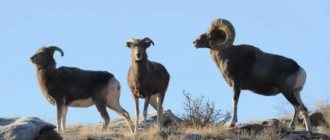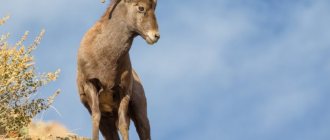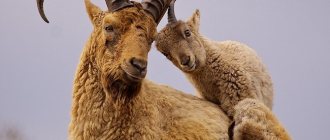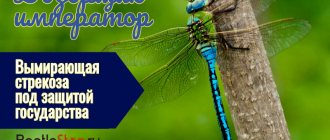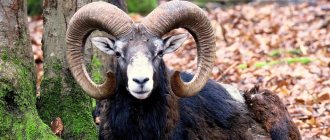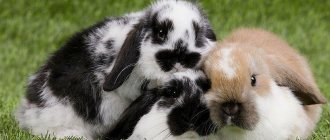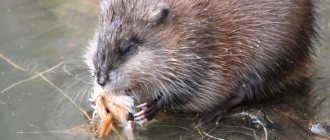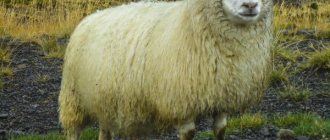Fauna
Material Information
Ovis ammon ammon - Order Artiodactyla - Artiodactyls, Family Bovidae - Bovids
The largest of ten subspecies of argali sheep in the fauna of the CIS. In Russia, besides Altai, it lives only in Tyva. Outside of Russia, argali are found only in Mongolia. In general, this is a single habitat of the subspecies, and the animals, wandering, cross the state border. The numbers are low everywhere. Hybrids of Altai sheep with domestic sheep are of economic value. Work in this direction has recently begun in one of the mountain villages of Mongolia. The Altai name is Kochkor.
Status. I category. A subspecies of argali that is endangered. Included in the Red Books of the USSR and the RSFSR.
Description
Photo:
Height at the withers - 70-125 cm, body length - 1.2-2 m, tail length 13-14 cm, body weight - 70-180 kg. Life expectancy is 12-18 years.
As already mentioned, the Altai ram is the largest ram. The height of an adult can reach 125 centimeters and a length of two meters.
These are strong herbivores with corresponding horns. In the Altai ram they are hollow, very wide and wrapped in such a way that the edges stick out forward.
In this case, the main part of the horn is a horn loop facing the back of the animal.
Horns play a big role in the role of a ram. With the help of them, the animal not only protects itself from natural enemies, but also participates in widespread fights during the breeding season.
Like all members of the sheep family, the Altai mountain sheep is a herbivore.
The basis of its diet is a variety of cereals, sedge, buckwheat and other herbs. In winter, in the absence of a proper food supply, animals migrate.
In particular, they descend from the mountains and graze on the plains. To find suitable pasture, the Altai mountain sheep can migrate up to 50 kilometers.
Appearance
Individuals are the largest horned of their species, in addition, this breed is famous for the fact that the males have large and massive horns.
The body structure of the animal is quite strong, the skeleton and muscles are well developed, the rams are large and strong. The male reaches a height of over 122 cm at the withers, and the female reaches 114 cm. These 10 cm differences are sometimes difficult to notice, since females and males are often approximately the same height. In kilograms, a male is very different from a female: a female can weigh a maximum of 102-104 kg, while a male can weigh 200-210 kg. Both representatives of the Altai mountain sheep genus have horns.
Rams of the Altai breed are distinguished by massive horns
Horns are the pride of this breed. In older rams, they can reach more than 152 cm, while their girth will be 56 cm, and they will weigh 23-24 kg. Of course, females have smaller horns and they are not as dangerous as the male’s horns. On average, the length of a female’s horns can reach 120-130 cm. At the same time, their girth is 25-35 cm, and their weight is from 10 to 15 kg. They change color depending on the time of year. Typically, the body cover has a brown or brown color closer to cold weather, and in spring-summer it changes to light with an admixture of gray and red tones.
This species always has a slightly lighter belly and back of the body. In this case, white and gray shades most often predominate, sometimes with an admixture of red. Experts noted that older representatives of this species are often much darker than everyone else in the pen. In summer, animals are characterized by a molting period; they can also change their colors during this period from light, almost white, to a dull red hue. At such moments, rams can be a little aggressive, as their skin is very itchy due to the molting period. A detailed description will help you understand all the intricacies.
Habitat
Today there are only three points on the globe where you can see the Altai mountain goat:
- In the Chulshman region;
- In the area of the Sailyugem mountain range;
- On the section between Mongolia and China.
It goes without saying that the places where the sheep live are carefully protected and are a protected area.
The favorite place of mountain goats is mountainous terrain. At the same time, they do not need abundant vegetation - small shrubs from the round-leaved subspecies will be quite enough for them.
In the hot season, mountain sheep can eat two or three times, but as for watering places, the opposite is true - they replenish the water reserves in their bodies once every three days.
Number of individuals and how the situation has changed
At the end of the 18th century, mountain sheep were spotted on the Tigiretsky ridge and on the nearby mountain ranges. Then, at the beginning of the 19th century, they were said to live in the mountains, which are located near the Argut River and on the Chulshman Plateau.
Already at the end of the 19th century and the beginning of the 20th they said that they moved again, this time to Sailyugem. At first, the number of Altai sheep was 600 individuals, then the number sharply decreased to 230-245. As of 1995, there were 320 of them, including adults and calves.
Number
At the beginning of the 20th century, the number of Altai mountain sheep reached 600 individuals. Somewhat later, their number sharply decreased - to 245.
By carrying out conservation measures and relocating adult individuals to protected areas, it was possible to slightly increase the number - up to 320 individuals, including both cubs and adult representatives of this breed.
They tried to breed the breed under artificial conditions - in zoos in Germany and America, but, unfortunately, the attempts were unsuccessful. In most cases, the animals died within a few weeks.
The only long-living animal was the mountain sheep, which was bred at the Biological Institute of Russia - it lived for six years. Obviously, this breed needs to be kept only in natural conditions for them, or at least in as similar conditions as possible.
The Novosibirsk Zoo is engaged in saving the species, as well as serious attempts to increase the population. This institution is the only one in the world where anyone can see Altai mountain sheep. Another interesting fact is that the rams kept here successfully give birth to offspring.
Zoo scientists drew up a plan for raising and releasing young lambs into the wild.
As part of this activity, four males were released into their natural habitat in September 2022 and raised separately in a special enclosure. The event was successful, and the animals went into the forest.
According to experts, they should meet a large herd of wild sheep located in the release area and become part of it.
Interesting fact: Mountain sheep are listed as a vulnerable species in the international Red Book. Also included in the Red Book of Russia.
Mouflon - mountain sheep
The only wild sheep that has wandered into Europe is the European mouflon, and sometimes the Asian one is also found. This is a relatively small animal, weighing about 50 kilograms. Horns are also very impressive, but females grow them very rarely.
It is worth noting that the Asian mouflon, compared to the European one, is an order of magnitude larger. It weighs up to 75 kilograms, and its body length reaches one and a half meters. This animal is an order of magnitude larger than an ordinary domestic sheep and has a strong, dense build. The habitat is limited to rocky and mountainous terrain. Oddly enough, there is no industrial value that the mountain sheep (mouflon) represents. Despite this, representatives of this species are actively hunted. Probably every hunter wants to have a trophy like a mouflon horn.
Breeding
They tried to breed the described species in zoos in Germany and America, but the animals always died after living for several months, or even days. The longest a representative of the Argali genus lived in captivity was 6 years at the Biological Institute of Siberia, Russia.
Obviously, mountain sheep should be kept close to their natural habitat or similar conditions should be created and good care should be provided.
Rocks stick together, forming large herds. Females always walk alone. Males always try to move in such a way as to be able to protect their females and cubs in any situation.
Usually the mating season begins in November, the female carries the cubs for 5 months, and already in early May gives birth to only one lamb. Argali lambs are born completely independent and immediately stand on their feet.
About animal protection
In recent years, mountain goats and sheep have been exterminated. The population is gradually decreasing for several reasons. Firstly, this is uncontrolled shooting by poachers, and secondly, the displacement of animals from their natural habitats. This is due to the fact that livestock grazes in these territories, which eats most of the food of argali, mouflon, etc. This leads to the fact that animals must look for new places for food and residence. Often as a result of this, part of the herd dies either at the hands of hunters or predators such as wolverines, wolves, snow leopards, etc.
To preserve the population, reserves are opened where hunting animals is prohibited. And since mountain sheep feel great in captivity, where they reproduce, this makes it possible to increase the number of the genus. The most famous case of illegal hunting of mountain sheep was in 2009. Then a helicopter crashed over Altai, carrying high-ranking officials and businessmen who were hunting these animals. The case immediately received wide publicity, but the complaint was rejected in court. As noted a little above, it is difficult to talk about numbers, since the animal is wild and lives where there are no people.
What is WWF doing to conserve the argali?
All argali groups in our country are concentrated on the border with Mongolia. Argali is a migratory species, animals are constantly moving from one country to another, so censuses of argali numbers and environmental measures are carried out simultaneously on both sides of the border.
Every year, specialists from Russia and Mongolia organize joint censuses of the argali population, clarify the boundaries of the groups’ habitats, and adjust environmental plans depending on the results.
WWF and partners first monitored the number of argali in 2003, estimating the number of argali in the transboundary territory between Russia, Mongolia and Kazakhstan at 1080-1170 individuals.
As part of the Foundation’s work, a project for the conservation of argali has been launched in the Altai-Sayan ecoregion, which involves the involvement of the border service, the creation of new protected areas and anti-poaching groups.
In 2011, WWF experts prepared a “Program for monitoring the Altai mountain sheep argali in the transboundary zone of Russia and Mongolia.”
In 2014, the results of a census of the transboundary population of the Altai mountain sheep showed a 23% increase in numbers over two years.
In total, experts counted 2,400 individuals in Russia and Mongolia. In 2015, for the first time in many years, argali were captured by camera traps on the Tsagan-Shibetu ridge in Tuva. This fact is unique, since it was believed that argali are extremely rare in this part of Tuva, and the range of the mountain sheep is shrinking.
Based on the results of surveys in 2016, it was revealed that 1198–1199 argali individuals live in Russia. Of these, 1,168 argali are in the Altai Republic (838 in the Sailyugemsky National Park, 330 individuals on the Chikhachev Ridge, Altai Mountains), 30 argali are in the Republic of Tuva.
The total number of a single group on the border of Russia and Mongolia is 3898–3899 animals.
The main threat to the existence of argali in Tuva, as well as in Russia as a whole, is poaching. Argali are shot for a trophy - the horns of males and for food.
WWF has been working on the conservation of argali in Russia for many years. The Foundation promotes anti-poaching activities, organization of international Russian-Mongolian research and registration of argali.
WWF specialists participate in the development of materials for official programs for the protection of the species in our country and in the creation of protected areas in the argali habitats.
Since 2003, according to WWF records, the number of argali in the transboundary zone of Russia and Mongolia has remained stable.
The Republic of Buryatia
Status: VI category. An extremely rare species that occasionally enters the Republic of Buryatia.
Spreading
There is no reliable information about the meetings. Nowadays, near Buryatia, the argali reliably lives only in the Khubsugul region (30 individuals) on the eastern slopes of the ridge. Khordil-Sardag. From the middle to the end of the 20th century. Occasionally, argali entered the Okinsky and Tunkinsky regions. Argali occasionally visits (1980-1990s) the sources of the river. Zhakhoy, including a unique high-mountain complex of natural solonetzes. At the end of June 2005, relatively large round footprints were discovered here on clay soil, which probably belonged to a male argali.
Number
Entries from the adjacent territories of Mongolia (Khubsugul region) are extremely rare, although not excluded.
Source: Red Book of the Republic of Buryatia: Rare and endangered species of animals, plants and fungi. Abasheev R.Yu., Azovsky M.G., Alekseev S.S. and others (2013) Ulan-Ude: Publishing House of the BSC SB RAS
